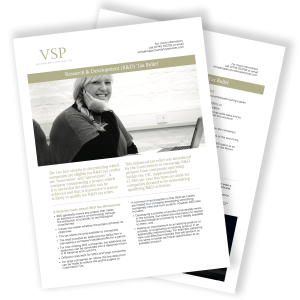Introduced by the Government to encourage Research and Development (R&D) projects from UK-based companies, R&D is a very generous tax relief.
It can be claimed by a range of companies that seek to research or develop an advance in their field.
A claim can mean a significant reduction in your Corporation Tax bill, or even repayment of a tax credit if the company has generated losses.
Sound good? Find out whether you qualify for R&D tax relief below.
Does my project qualify for R&D tax relief?
If your project meets HMRC’s definition of R&D, you are able to claim R&D tax credits.
Your R&D project needs to make an advance in science or technology* and be relevant to your company’s trade.
*This excludes social sciences, such as economics, or theoretical fields, such as pure mathematics.
You will need to be able to clearly explain to HMRC how your project:
- Looked for an advance in science or technology.
- Had to overcome ‘uncertainty’.
- Tried to overcome this ‘uncertainty’.
- Couldn’t be easily worked out by a professional in the field.
See below for common misconceptions around R&D tax relief.
Can I claim R&D tax relief?
R&D tax relief can only be claimed by companies and there are different types of relief dependent on the size of your companies.
SMEs.
Small to medium-sized enterprises can qualify for SME R&D relief, which grants them tax relief on 230% of the qualifying expenditure. This means the expenses associated with R&D will be an allowable deduction, together with an additional deduction of 130% of these costs in the company’s tax computations.
Meanwhile, for loss-making SMEs, the additional losses created by the R&D claim can be surrendered in exchange for a tax credit from HMRC. As of 1 April 2014, the rate of tax credit available is 14.5%.
It is important to note that a claim can only be made if the company is a going concern and not in either administration or liquidation at the time of the claim.
An SME is defined by a company that employes less than 500 full-time employees during a given year and has either: an annual turnover of < £100m; or Balance Sheet total < £86m. These limits apply on a group-wide basis and so related companies are taken into account.
Large companies.
An additional 30% is available for large companies, which means a 130% tax relief on the qualifying costs incurred.
On top of this, an above the line deduction can be made for qualifying expenditure (as of 1 April 2014).
For larger businesses, the amount of tax credit received is subject to a cap, based on the PAYE and NI incurred.
How do I make a claim for R&D tax relief?
Your claim for R&D tax relief should be made within two years of the end of the accounting period in question. This claim needs to be included on your Corporation Tax return and it is best practice to include an R&D report as an accompaniment to the tax return.
R&D Tax Relief Myth Busters:
- Your project does not have to meet its objectives.
- Tax reliefs are only available to companies.
- Different rates exist for SMEs and large companies.
- R&D tax credits are not exclusive to companies developing something completely new or from scratch – you can be developing a process or product that already exists in the industry, or make an improvement to an existing product or process.
We’re specialists in preparing R&D reports and associated calculations for submission to HMRC. Please contact Vicky at VSP Accountancy Services Limited or call us today if you would like any more information.
In the meantime, download VSP Accountancy Services Printable Guide To R&D Tax Relief.


